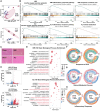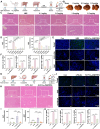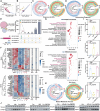Integrated cascade antioxidant nanozymes-Cu5.4O@CNDs combat acute liver injury by regulating retinol metabolism
- PMID: 40365282
- PMCID: PMC12068305
- DOI: 10.7150/thno.106811
Integrated cascade antioxidant nanozymes-Cu5.4O@CNDs combat acute liver injury by regulating retinol metabolism
Abstract
Background: Acute liver failure (ALF) represents a critical medical condition marked by the abrupt onset of hepatocyte damage, commonly induced by etiological factors such as hepatic ischemia/reperfusion injury (HIRI) and drug-induced hepatotoxicity. Across various types of liver injury, oxidative stress, heightened inflammatory responses, and dysregulated hepatic retinol metabolism are pivotal contributors, particularly in the context of excessive reactive oxygen species (ROS). Methods: C-dots were combined with Cu5.4O USNPs to synthesize a cost-effective nanozyme, Cu5.4O@CNDs, which mimics the activity of cascade enzymes. The in vitro evaluation demonstrated the ROS scavenging and anti-inflammatory capacity of Cu5.4O@CNDs. The therapeutic potential of Cu5.4O@CNDs was evaluated in vivo using mouse models of hepatic ischemia/reperfusion injury and LPS/D-GalN induced hepatitis, with transcriptome analysis conducted to clarify the mechanism underlying hepatoprotection. Results: The Cu5.4O@CNDs demonstrated superoxide dismutase (SOD) and catalase (CAT) enzyme activities, as well as hydroxyl radical (·OH) scavenging capabilities, effectively mitigating ROS in vitro. Furthermore, the Cu5.4O@CNDs exhibited remarkable targeting efficacy towards inflammation cells induced by H2O2 and hepatic tissues in murine models of hepatitis, alongside exhibiting favorable biocompatibility in both in vitro and in vivo settings. Moreover, it has been demonstrated that Cu5.4O@CNDs effectively scavenged ROS, thereby enhancing cell survival in vitro. Additionally, Cu5.4O@CNDs exhibited significant therapeutic efficacy in mice models of HIRI and lipopolysaccharide-induced acute lung injury (LPS-ALI). This efficacy was achieved through the modulation of the ROS response and hepatic inflammatory network, as well as the amelioration of disruptions in hepatic retinol metabolism. Conclusions: In summary, this study demonstrates that Cu5.4O@CNDs exhibit significant potential for the treatment of various acute liver injury conditions, suggesting their promise as an intervention strategy for clinical application.
Keywords: Acute liver injury; C-dots nanozymes; Cu5.4O nanoparticles; Hepatic ischemia-reperfusion injury; Reactive oxygen species.
© The author(s).
Conflict of interest statement
Competing Interests: The authors have declared that no competing interest exists.
Figures










Similar articles
-
Ultrasmall Antioxidant Copper Nanozyme to Enhance Stem Cell Microenvironment for Promoting Diabetic Wound Healing.Int J Nanomedicine. 2024 Dec 19;19:13563-13578. doi: 10.2147/IJN.S487647. eCollection 2024. Int J Nanomedicine. 2024. PMID: 39720217 Free PMC article.
-
Ultrasmall copper-based nanoparticles for reactive oxygen species scavenging and alleviation of inflammation related diseases.Nat Commun. 2020 Jun 3;11(1):2788. doi: 10.1038/s41467-020-16544-7. Nat Commun. 2020. PMID: 32493916 Free PMC article.
-
An Oral H2S Responsive Cu5.4O Nanozyme Platform with Strong ROS/H2S Scavenging Capacity for the Treatment of Colitis.ACS Appl Mater Interfaces. 2025 Jan 8;17(1):617-631. doi: 10.1021/acsami.4c17782. Epub 2024 Dec 25. ACS Appl Mater Interfaces. 2025. PMID: 39722133
-
Carbon dot nanozymes as free radicals scavengers for the management of hepatic ischemia-reperfusion injury by regulating the liver inflammatory network and inhibiting apoptosis.J Nanobiotechnology. 2023 Dec 21;21(1):500. doi: 10.1186/s12951-023-02234-1. J Nanobiotechnology. 2023. PMID: 38129928 Free PMC article.
-
Copper-Based Nanoparticles for Effective Treatment Against Sepsis-Induced Lung Injury in Mice Model.Int J Nanomedicine. 2024 Dec 17;19:13507-13524. doi: 10.2147/IJN.S488357. eCollection 2024. Int J Nanomedicine. 2024. PMID: 39713221 Free PMC article.
References
-
- Bernal W, Lee WM, Wendon J, Larsen FS, Williams R. Acute liver failure: A curable disease by 2024? J Hepatol. 2015;62(1 Suppl):S112–120. - PubMed
-
- Wendon J, Cordoba J, Dhawan A, Larsen FS, Manns M, Samuel D. et al. Easl clinical practical guidelines on the management of acute (fulminant) liver failure. J Hepatol. 2017;66(5):1047–1081. - PubMed
-
- Bernal W, Wendon J. Acute liver failure. N Engl J Med. 2013;369(26):2525–2534. - PubMed
-
- Bajaj JS, Cordoba J, Mullen KD, Amodio P, Shawcross DL, Butterworth RF. et al. Review article: The design of clinical trials in hepatic encephalopathy - an international society for hepatic encephalopathy and nitrogen metabolism (ishen) consensus statement. Aliment Pharmacol Ther. 2011;33(7):739–747. - PMC - PubMed
MeSH terms
Substances
LinkOut - more resources
Full Text Sources
Medical
Miscellaneous

